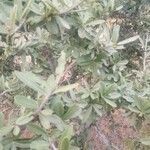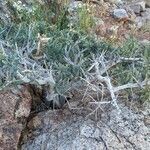The appearance of the tree varies in different places. It is a tree. It can be 3-4.5 m tall. The trunk is long and clean. It is white. The crown is neat and dense. In other places the trunks may be dark the the leaves drooping. It can also be a low many stemmed shrub. The leaves are grey-green. They are hard when mature. They are usually 2.5-5 cm long and narrow. They taper at the base and have short thin stalks. The midrib is prominent under the leaf. Mostly the leaves grow in bunches of 4-5 together. The flowers are small and star shaped. They are yellow and have a sweet smell. They are usually on old wood and in the axils of leaves. The fruit is round and smooth. It is usually green then turns light brown. It is acrid and edible.
Small to medium-sized tree, to 7 m, with a rounded crown. Main stem: white or whitish grey; branches stout and crooked. Leaves: clustered, rarely alternate; oblanceolate (20-50 x 6-25 mm); apex rounded, often bristle-tipped, base tapering; leathery, greyish-green, leaf surface similar in colour on both sides; side veins barely visible on both sides; hairy or glabrous; margin entire; petiole usually hairy, 2-8 mm long. Flowers: axillary, in short clusters; small, yellowish green, heavily-scented. Fruit: a hairless round berry, yellowish, 5-12 mm diam. (Dec-Mar).
Tree (or rarely a shrub), up to 7 m high. Crown rounded. Bark smooth, grey to whitish grey. Leaves fascicled, with lateral veins indistinct and similar in colour on both surfaces; blade narrowly obovate to elliptic, 15-80 x 4-20 mm, stiff and leathery. Flowers: in dense clusters on short branchlets; perianth yellowish green; Sep.-Dec. Fruit a berry, 5-12 mm in diameter, glabrous, dull red when mature.
Leaves alternate or fascicled 2–4 together on very reduced side-shoots; lamina 3–5 x 0.7–1.2 cm., coriaceous, oblanceolate or narrowly oblong, apex rounded or retuse or very rarely acute, mucronate, narrowed to a cuneate or narrowly rounded base, puberulous on both sides or glabrescent, midrib prominent beneath, nervation scarcely visible; petiole 1–3 mm. long, puberulous.
Stocky, evergreen tree, up to 7 m tall or rarely shrubby, with conspicuous whitish grey bark. Leaves oblanceolate to elliptic, 15-50 x 4-15 mm, leathery, grey-green on both surfaces. Flowers small, greenish sweetly scented. Fruit a spherical berry, 5-12 mm diam., glabrous, yellow.
Inflorescence of very short, dense, axillary racemes; peduncle almost 0, rachis pubescent; bracteoles 1.5 mm. long, filamentous, pubescent, trifid with the middle lobe longest; pedicels up to 5 mm. long, pubescent.
Sepals 4 x 2.5–3 mm., ovate-oblong, apex subacute, very minutely puberulous outside, pubescent within, densely so at the margins; receptacle disk-like, papillose-fimbriate.
Ovary ovoid, glabrous, with c. 10 ovules on 2 placentas; style 0.5 mm. long, glabrous; stigma subcapitate, scarcely wider than the style.
Much-branched tree up to 10 m. tall; crown dense and rounded; bark smooth and whitish; trunk stout.
Fruit up to 1 cm. in diam., globose, yellowish, glabrous, smooth.
Seed usually single, c. 0.7 cm. in diam., subglobose, rugose.
Stamens 6–14, on glabrous filaments c. 5 mm. long.
Gynophore c. 3 mm. long, glabrous.


